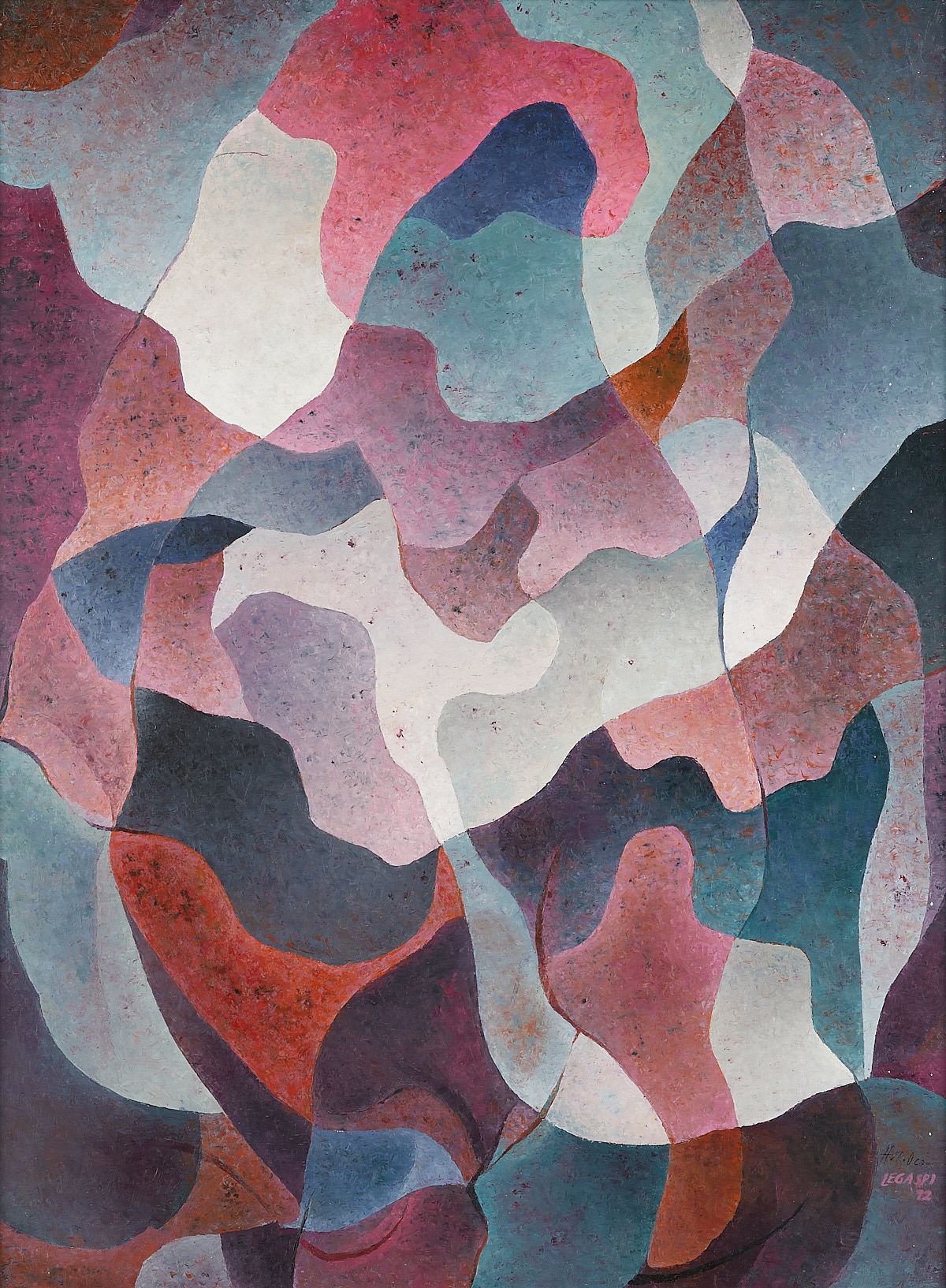
Cesar Legaspi (Filipino, 1917-1994) and Hernando R. “HR” Ocampo (Filipino, 1911-1978). Oil on board painting from the “Interaction” series, 1972. Depicting interlocking forms in muted reds and blues that are iconic of Ocampo’s “visual melody” period. The highly textured painting shows the signature look of Ocampo’s paintings, who meticulously applied paint to his canvases with a small palette knife in methodical, small increments, changing from shade to shade with patience and care. Signed by both artists and dated by Legaspi along the lower right. With a label from the Cultural Center of the Philippines affixed along the verso. Exhibition: Cultural Center of the Philippines, “Interaction 1973,” May 25 – June 24, 1973.
Lot Essay: Both Legaspi and Ocampo were a part of the influential group known as the “Thirteen Moderns” who ushered in a modern style of painting to the Philippines. The group included Botong Francisco, Galo Ocampo, Lorenzo, Vicente Manansala, HR Ocampo, Anita Magasaysay-Ho, Cesar Legaspi, Demetrio Diego, Ricarte Purugganan, Jose Pardo, Bonifacio Cristobal and Arsenio Capili. This group interacted with each other often, collaborating to produce greater and greater works of art. Cesar Legaspi was a Filipino National Artist in painting. His early works often depicted cubist figures often described as showing the anguish and dehumanizing of the beggars and laborers in the city. In his early works he worked to refine Cubism and place it within a distinctly Filipino context, utilizing it to show the struggles his country faced in the wake of World War II. His focus on the human condition never faded even as he moved to a brighter palette and more abstract, geometric forms. He studied at the University of the Philippines and under the tutelage of Pablo C. Amorsolo before exhibiting his works at the Manila Hotel with other neo-realists in 1950. He held his first one-man show in 1963 at the Luz Gallery after studying for several years in Madrid and Paris.
Until 1968 he split his time between working in advertising and painting before finally devoting his career to his artistic endeavors. He eventually became the head of the Saturday Group of Artists from 1978 until his death in 1994. Together with Legaspi and Vicente Manansala, Hernando Ruiz Ocampo (better known as HR Ocampo) was one of the three most significant figures who brought neo-realism to the Philippines. Ocampo was a self-taught artist whose works were noted for their unity and coherence throughout his career. As he shifted from neo-realism to abstract works in the 1960s, he began using more vivid paints and his paintings were sometimes likened to paint-by-number artworks. His works are self-defined by five distinct periods: the Amorsolo period from 1929-1934, the proletarian period from 1934-1945; the transitional period from 1945-1963; the mutants period from 1963-1968; and the visual melody period from 1968-1978.
In addition to his inventive paintings, he was also a writer, playwright, and editor. He combined his love of art and writing for the creation of the monumental “Genesis” curtains in the Cultural Center of the Philippines’ Tanghalang Nicanor Abelardo. In his signature undulating forms of red, orange, and yellow, these curtains define his style and personality.
Sight; height: 23 1/2 in x width: 17 1/2 in.
Framed; height: 25 in x width: 19 in.
$19,000